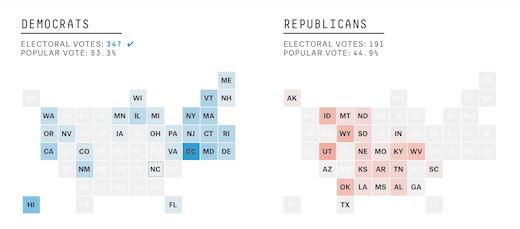The Upcoming Battle For Upscale Whites

How did I not know about this before now?
How the Swing-O-Matic works: We started with the results of the 2012 election and the support for each party’s candidate by the five demographic groups. We then adjusted the size of those groups based on four years of population change. When you adjust the vote and turnout above, our model recalculates the results for each state — as well as the Electoral College outcome and the national popular vote — taking into account how much of the state’s electorate the group accounts for.
The toggles control assumptions about voting behavior for five different demographic groups: College-educated White, Non-college-educated White, Black, Hispanic/Latino and Asian-American/Other. You control two factors for each group: turnout and partisan breakdown. Set your assumptions for each group, and voila: a prediction for the 2016 Presidential election.
For my chart above, I made the following assumptions about how voting behavior will change:
- College-educated white voters shift significantly towards the Democrats, going from 56% Republican-leaning in 2012 to 55% Democratic-leaning in 2016. But turnout in this group also drops significantly, from 77% to 70%. Basically, I’m assuming upscale Republican moderates will partly swing toward Clinton while upscale conservative Republicans will to some degree stay home.
- Non-college educated white voters shift the other way, going from 62% Republican-leaning to 70% Republican-leaning. And their turnout also goes up, from 57% to 65%. This is the Trump bump, bringing out infrequent voters from this demographic segment, and also swaying more regular voters further in a Republican direction.
- Black voters shift very slightly towards Clinton (their Democratic percentage really can’t go much higher), from 93% to 95%. But their turnout drops from 66% to 60%. This reflects the fact the toxicity of Trump’s campaign on the one hand, but the fading of the Obama effect (particularly among younger voters) on the other hand.
- Hispanic/Latino voters shift toward the Democrats, going from 71% to 75%, and see a bump in turnout as well, from 48% to 55%. And Asian-American and Other voters do the same, going from 67% Democratic-leaning to 75%, and from 49% turnout to 55%. This reflects a strongly negative reaction to Trump’s anti-immigrant stance.
The result is a clear victory for Clinton in both the popular vote and the electoral college.
The magnitudes are obviously made up, but I do suspect I’ve got the direction right in terms of turnout and partisan tilt. Trump will bring out more downscale white voters. The question is how many. Some GOP-leaning upscale whites will either vote Clinton or stay home in disgust at the choice presented. The question is how many. Black turnout will probably go down without Obama on the ballot. The question is how much. Hispanic and Asian-American turnout will probably go up because of Trump’s anti-immigrant posturing. The question is how much.
Assuming I’m right about all of that, I decided to make a map of a popular-vote tie (Trump wins with 273 electoral votes) with the following premises:
- Non-college-educated whites shift toward Trump as in the previous scenario: 70% for the GOP (versus 62% in 2012) and 65% turnout (versus 57% in 2012).
- Black voter turnout drops to 60% as in the previous scenario (from 66% in 2012).
- Hispanic/Latino and Asian-American turnout rises by 2%, and shifts 3% towards the
RepublicansDemocrats. - Turnout for college-educated whites drops to 70% (from 77% in 2012), but only shifts 2% towards the Democrats, ending at 53% Republican.
Here’s the map:
In this scenario, Florida, Wisconsin and New Hampshire are all on a knife-edge, with Iowa and Ohio not far behind.
Obviously, these are oversimplified models – but they aren’t meaningless. My primary take-home is this:
If Donald Trump can make significant gains among working-class whites, that ground will be hard for Democrats to recover merely by winning more black, Hispanic and Asian-American votes (though they will absolutely seek to expand in those demographics as well). So the Democratic strategy will perforce be focused on a combination of winning over more upscale whites and limiting Trump’s appeal to downscale whites.
The challenge will be doing both of those things at once.
The good news for Team Clinton is: they start out far enough ahead that they don’t have to do that good a job of either in order to win.

Comments